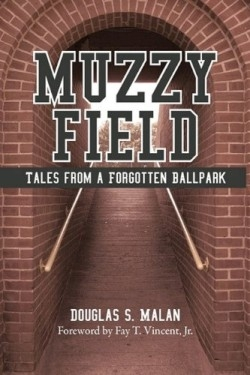Muzzy Field
Tales From a Forgotten Ballpark
- 2009 INDIES Finalist
- Finalist, Sports (Adult Nonfiction)
Every small town doesn’t have a ball park like Muzzy Field in Bristol, Connecticut—but it should. This is Americana. This is old-time baseball. In his first book, sports journalist Douglas Malan chronicles the history of one of the country’s oldest fields, one shared by top-level professional teams and low-level high school squads.
After a chapter on the introduction of baseball to Connecticut in the mid-nineteenth century, the book really takes off. Malan has the eye and patience of a local historian, which has its advantage as well as its drawbacks. For local readers interested in the topic, his project is a great resource. For those who fall outside city limits, however, Malan might offer too much information about Bristol businesses—primarily the New Departure Manufacturing Company, which fielded a successful semi-pro team for many years.
Babe Ruth and the Yankees played at Muzzy Field, as did Martin Dihigo, one of the all-time greats in the Negro Leagues (Malan presents the town as more progressive than most of its era when it comes to race relations).
Like the rest of the country, Muzzy Field had its good years and its lean. The ball park enjoyed its heyday before the Great Depression as Major League teams would barnstorm their way across the country to pick up a few extra dollars and give far flung fans a chance to see their heroes play, an opportunity that would otherwise be impossible in a pre-television era.
Muzzy Field wasn’t just for baseball. High school, college, and semi-pro football and soccer teams used the facilities as well, and it served as the locale for civic functions such as company picnics attended by hundreds of townsfolk.
By the middle of the twentieth century, the site became home to minor league baseball, specifically the Eastern League franchise of the Boston Red Sox. Citizens had a chance to see such players as Jim Rice, Butch Hobson, and Fred Lynn before they became big stars.
Like its human inhabitants, the field aged and found itself in need of occasional repair. Such information is part of the overall picture, but unless the reader is studying urban infrastructure, this is where Muzzy Field bogs down slightly.
The presentation is well organized, although index is arranged alphabetically by first name rather than last name, which might catch some researchers off guard.
Sadly, economic realities have resulted in hard times for the field. But Malan’s efforts have resulted in a marvelous resource that will serve Bristolians and historians well in the decades ahead.
Disclosure: This article is not an endorsement, but a review. The publisher of this book provided free copies of the book and paid a small fee to have their book reviewed by a professional reviewer. Foreword Reviews and Clarion Reviews make no guarantee that the publisher will receive a positive review. Foreword Magazine, Inc. is disclosing this in accordance with the Federal Trade Commission’s 16 CFR, Part 255.

